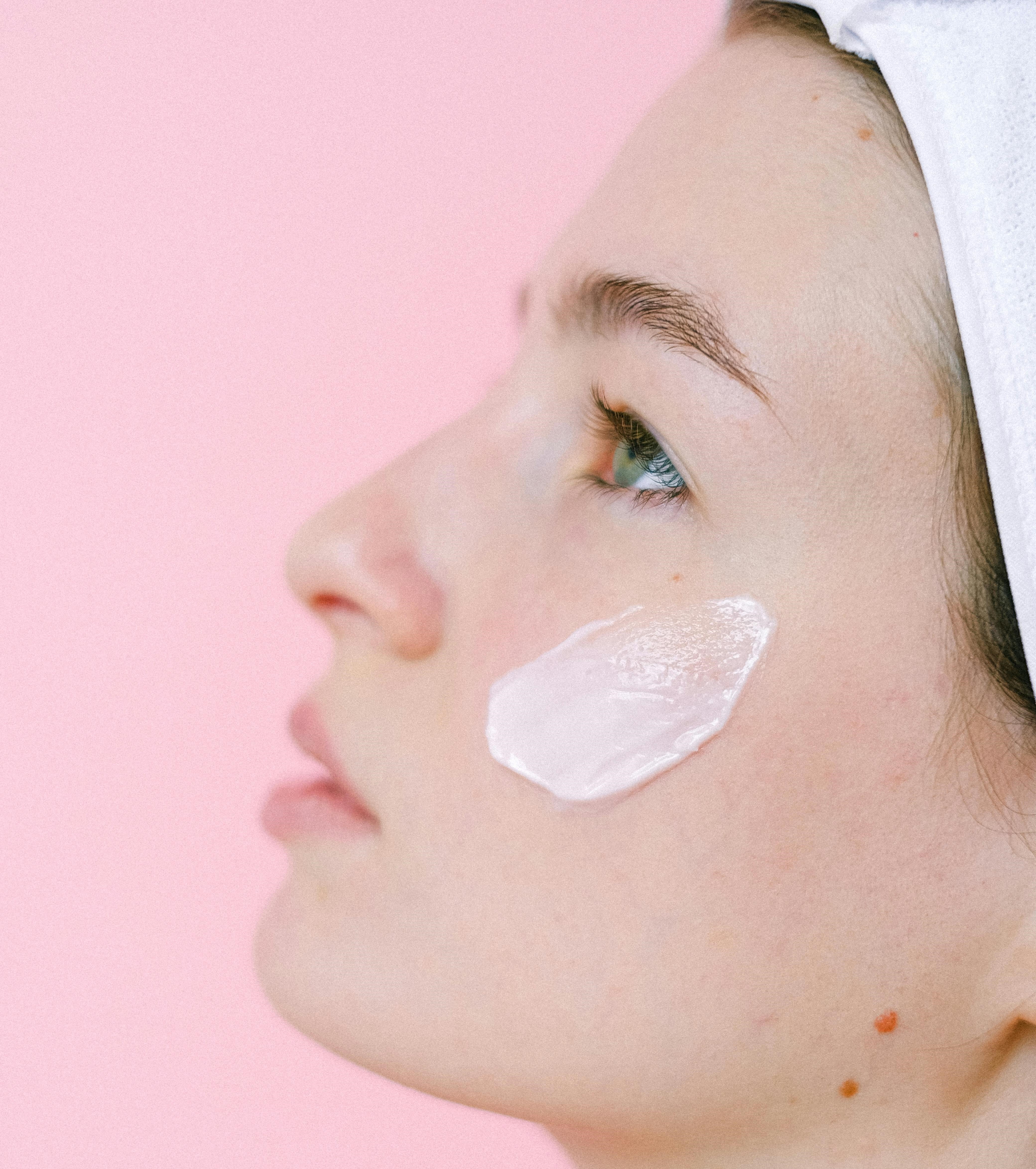เติมน้ำให้ผิวอย่างมืออาชีพ: คู่มือฉบับสมบูรณ์สำหรับผิวบอบบางแพ้ง่าย
คุณรู้จักความรู้สึกตึงๆ หลังล้างหน้าไหม? ความหมองคล้ำที่บดบังความเปล่งปลั่งตามธรรมชาติของผิว? ริ้วรอยเล็กๆ และรอยลอกที่ยิ่งทำให้แย่ลงเมื่อแต่งหน้า? สิ่งเหล่านี้คือสัญญาณที่ชัดเจนว่าผิวของคุณกำลังขาดน้ำ
เรื่องนี้ไม่ใช่แค่เรื่องรูปลักษณ์ภายนอก แต่ยังเกี่ยวกับสุขภาพผิวด้วย เมื่อผิวขาดน้ำ เกราะป้องกันผิวก็จะอ่อนแอลง ทำให้ผิวระคายเคืองและแก่ก่อนวัย
คู่มือนี้จะแนะนำวิธีการเติมความชุ่มชื้นให้ผิวอย่างครบถ้วนและทีละขั้นตอน โดยเราจะให้ความสำคัญกับผู้ที่มีผิวแพ้ง่ายเป็นพิเศษ ความชุ่มชื้นที่แท้จริงและยั่งยืนเปรียบเสมือนระบบนิเวศ มาจากผลิตภัณฑ์ที่เหมาะสม กิจวัตรประจำวันที่สม่ำเสมอ และการเลือกวิถีชีวิตที่ดีต่อสุขภาพ มาสร้างระบบนิเวศนี้ให้กับผิวของคุณกันเถอะ
ผิวขาดน้ำ vs. ผิวแห้ง
คุณจะรู้ได้อย่างไรว่าผิวของคุณขาดน้ำ? ขั้นแรก คุณต้องระบุปัญหาให้ถูกต้อง หลายคนมักสับสนระหว่างภาวะขาดน้ำกับภาวะผิวแห้ง ซึ่งทำให้เลือกใช้ผลิตภัณฑ์ที่ไม่ถูกต้องและไม่ได้ผลลัพธ์
ผิวขาดน้ำจะขาดน้ำ ผิวแห้งจะขาดน้ำมันตามธรรมชาติหรือซีบัม ผิวทุกประเภทสามารถขาดน้ำได้ ไม่ว่าจะเป็นผิวมัน ผิวผสม หรือผิวธรรมดา
ผิวของคุณอาจรู้สึกตึง โดยเฉพาะหลังจากทำความสะอาดผิว คุณอาจสังเกตเห็นริ้วรอยเล็กๆ ใหม่ๆ เกิดขึ้นเมื่อคุณยิ้ม ลองทดสอบง่ายๆ นี้: บีบผิวเบาๆ บนแก้มของคุณ หากผิวของคุณใช้เวลานานกว่าจะฟื้นตัว แสดงว่าผิวของคุณอาจขาดน้ำ
สัญญาณทั่วไปของผิวขาดน้ำมีดังนี้:
- ความไวมากขึ้นกว่าปกติ
- ผิวหน้าหมองคล้ำ ดูเหนื่อยล้า
- ริ้วรอยเล็กๆ ที่คุณมองเห็นได้
- ความตึงกระชับแม้ผิวจะมัน
- อาการคันหรือผิวหยาบ
ตารางนี้แสดงความแตกต่างที่สำคัญเพื่อช่วยให้คุณทราบว่าผิวของคุณต้องการอะไรจริงๆ
|
คุณสมบัติ |
ผิวขาดน้ำ |
ผิวแห้ง |
|
สาเหตุ |
ขาดแคลนน้ำ |
ขาดน้ำมันธรรมชาติ (ซีบัม) |
|
ความรู้สึก |
แน่น หยาบ ไม่สบาย |
หยาบ เป็นสะเก็ด บางครั้งคัน |
|
รูปร่าง |
ริ้วรอยหมองคล้ำและริ้วรอยเล็กๆ มองเห็นได้ชัดเจนยิ่งขึ้น |
ผื่นแดง ผื่นแพ้ระคายเคือง |
|
สามารถส่งผลกระทบได้ |
ทุกสภาพผิว (แม้กระทั่งผิวมัน) |
ประเภทผิวที่เฉพาะเจาะจง |
การเข้าใจความแตกต่างนี้จะช่วยให้คุณเลือกวิธีการรักษาที่ทำให้ผิวชุ่มชื้น ไม่ใช่แค่น้ำมันเพียงอย่างเดียว ซึ่งจะช่วยแก้ไขสาเหตุที่แท้จริงของความรู้สึกไม่สบายผิวของคุณ
เสาหลักสามประการของการให้ความชุ่มชื้น

เพื่อให้ผิวชุ่มชื้นอย่างมีประสิทธิภาพ เราใช้วิธีง่ายๆ แต่ทรงพลัง นั่นคือ เติมความชุ่มชื้น คงสภาพผิว และล็อคความชุ่มชื้น กลยุทธ์สามขั้นตอนนี้ทำให้เข้าใจวิทยาศาสตร์เรื่องความชุ่มชื้นได้ง่าย ช่วยให้คุณวางแผนกิจวัตรประจำวันได้อย่างชัดเจน
ลองคิดดูว่ามันเป็นระบบ แต่ละขั้นตอนต่อยอดจากขั้นตอนก่อนหน้า เพื่อให้แน่ใจว่าน้ำจะซึมเข้าสู่ผิวและคงอยู่
เสาหลักที่ 1: เติมน้ำ
ขั้นตอนแรกนี้จะดึงน้ำเข้าสู่ผิวชั้นบนสุด เราทำเช่นนี้ด้วยส่วนผสมที่เรียกว่าสารเพิ่มความชุ่มชื้น
สารดูดความชื้นทำหน้าที่เสมือนแม่เหล็กดูดความชื้น พวกมันดึงน้ำจากอากาศและจากผิวชั้นลึกขึ้นสู่ผิว ตัวอย่างสำคัญ ได้แก่ กรดไฮยาลูโรนิก กลีเซอรีน และแพนทีนอล
คุณจะพบสารเหล่านี้ได้ในผลิตภัณฑ์บำรุงผิวประเภทน้ำ เช่น โทนเนอร์เพิ่มความชุ่มชื้น เอสเซนส์ และสเปรย์น้ำแร่บำรุงผิวหน้า สารเหล่านี้จะช่วยเติมน้ำให้กับผิวที่กระหายน้ำของคุณ ซึ่งเป็นสิ่งที่จำเป็นอย่างยิ่ง
เสาหลักที่ 2: กักเก็บน้ำ
เมื่อคุณเติมน้ำให้ผิวแล้ว เป้าหมายต่อไปคือการรักษาความชุ่มชื้นไว้ นี่คือที่มาของสูตรที่เข้มข้นกว่า
เซรั่มและมาส์กถูกออกแบบมาเพื่อจุดประสงค์นี้ โครงสร้างของผลิตภัณฑ์ช่วยให้ซึมซาบล้ำลึกกว่าโทนเนอร์ มอบส่วนผสมสำคัญเข้มข้นที่ช่วยให้ผิวกักเก็บความชุ่มชื้นไว้ได้
ขั้นตอนนี้ทำหน้าที่เหมือนอ่างเก็บน้ำ ช่วยให้เซลล์ผิวของคุณอิ่มน้ำและชุ่มชื้นยาวนานขึ้น
เสาหลักที่ 3: ล็อคความชื้น
ขั้นตอนสุดท้ายที่ขาดไม่ได้คือการสร้างผนึก ซึ่งสำคัญอย่างยิ่งในการหยุดยั้งการสูญเสียน้ำผ่านผิวหนัง (Transepidermal Water Loss: TEWL) ซึ่งเกิดขึ้นเมื่อน้ำระเหยออกจากผิว
เราทำเช่นนี้โดยใช้สารให้ความชุ่มชื้นและสารปิดกั้นผิว สารให้ความชุ่มชื้น เช่น เซราไมด์และสควาเลน จะช่วยเติมเต็มช่องว่างระหว่างเซลล์ผิว ทำให้ผิวเรียบเนียนและซ่อมแซมชั้นผิว สารปิดกั้นผิว เช่น เชียบัตเตอร์ หรือซิลิโคนที่เป็นมิตรต่อผิว เช่น ไดเมทิโคน จะสร้างฟิล์มป้องกันไว้ด้านบน
เสาหลักนี้คือมอยส์เจอไรเซอร์หรือครีมบำรุงผิวหน้าของคุณ ทำหน้าที่กักเก็บสารให้ความชุ่มชื้นจากโทนเนอร์และเซรั่มของคุณ เพื่อให้แน่ใจว่างานทั้งหมดของคุณจะไม่หายไปในอากาศ
ขั้นตอนการเติมน้ำ 5 ขั้นตอน
ทีนี้ มาเปลี่ยนสามหลักการนี้ให้เป็น กิจวัตรการดูแลผิวประจำวัน ที่ทำได้จริงกันเถอะ ความสม่ำเสมอคือกุญแจสำคัญในการเปลี่ยนผิวขาดน้ำให้กลับมามีผิวสุขภาพดี เปล่งปลั่ง
ขั้นตอนที่ 1: ทำความสะอาดอย่างอ่อนโยนและเติมความชุ่มชื้น
การเติมความชุ่มชื้นให้ ผิว เริ่มต้นด้วยการทำความสะอาด ผลิตภัณฑ์ทำความสะอาดผิวที่รุนแรงและทำให้ผิวรู้สึก "สะอาดหมดจด" เป็นสาเหตุหลักของภาวะขาดน้ำ สิ่งเหล่านี้จะทำลายเกราะป้องกันผิวของคุณ
เลือกผลิตภัณฑ์ทำความสะอาดที่มีค่า pH สมดุล ปราศจากซัลเฟต สูตรครีม นม หรือเจล จะช่วยขจัดสิ่งสกปรกโดยไม่ทำให้สูญเสียความชุ่มชื้นที่จำเป็น นี่คือรองพื้นของคุณ
ขั้นตอนที่ 2: ทาโทนเนอร์ลงบนผิวที่ชื้น
หลังทำความสะอาดผิวหน้า ขณะที่ผิวยังชื้นอยู่ ให้ทาโทนเนอร์หรือเอสเซนส์บำรุงผิว อย่าเช็ดหน้าให้แห้งสนิท
การทาผลิตภัณฑ์เพิ่มความชุ่มชื้นลงบนผิวที่เปียกชื้นคือเคล็ดลับของมืออาชีพ น้ำที่เหลืออยู่จะทำหน้าที่เป็นตัวพา ช่วยให้สารให้ความชุ่มชื้นในโทนเนอร์ดูดซึมได้ดีขึ้น และดึงความชุ่มชื้นนั้นเข้าสู่ผิวอย่างล้ำลึก
ขั้นตอนที่ 3: เติมพลังด้วยการเติมน้ำ
นี่คือขั้นตอน "คงสภาพ" ของคุณ เซรั่มเติมความชุ่มชื้นสูตรเข้มข้นจะมอบสารให้ความชุ่มชื้นเข้มข้นและส่วนผสมอื่นๆ ที่เป็นประโยชน์ ส่วนผสมเหล่านี้จะช่วยกักเก็บน้ำไว้ในผิวของคุณ
สำหรับการบำบัดอย่างเข้มข้น โดยเฉพาะอย่างยิ่งสำหรับผิวแพ้ง่าย มาส์กที่ตรงจุดสามารถเป็นระบบนำส่งที่มีประสิทธิภาพ เราขอแนะนำ Winona Soothing and Repairing การอบแห้งแบบแช่แข็ง มาส์ก ออกแบบมาเพื่อมอบความชุ่มชื้นอย่างล้ำลึก พร้อมเสริมสร้างเกราะป้องกันตามธรรมชาติของผิว เหมาะอย่างยิ่งสำหรับการเติมความชุ่มชื้นอย่างอ่อนโยนแต่ทรงพลัง เซรั่มเพิ่มความชุ่มชื้นที่ดีที่สุดตัวหนึ่งสำหรับผิวบอบบางแพ้ง่าย
ขั้นตอนที่ 4: ล็อคด้วยมอยส์เจอร์ไรเซอร์
ตอนนี้ คุณต้องล็อคทุกอย่างไว้ นี่คือขั้นตอน "ล็อค" ที่สำคัญที่จะช่วยหยุดไม่ให้ความชื้นทั้งหมดที่คุณเพิ่งทาระเหยไป
เลือก มอยส์เจอไรเซอร์ ที่เหมาะกับสภาพผิวของคุณ หากคุณมีผิวมันหรือผิวผสม โลชั่นเนื้อบางเบาหรือเจลครีมอาจช่วยได้ หากผิวแห้ง คุณควรใช้ครีมที่เข้มข้นขึ้น มีส่วนผสมของเซราไมด์และสารให้ความชุ่มชื้น ซึ่งจะช่วยเสริมการกักเก็บความชุ่มชื้นได้ดียิ่งขึ้น
ขั้นตอนที่ 5: ปกป้องด้วย SPF
หากคุณทำกิจวัตรนี้ในตอนเช้า ครีมกันแดดคือขั้นตอนสุดท้ายที่สำคัญ การสัมผัสแสงแดดเป็นสาเหตุหลักของความเสียหายต่อเกราะป้องกันผิว
รังสียูวีทำลายโครงสร้างผิว ส่งผลให้สูญเสียน้ำและขาดน้ำมากขึ้น ครีมกันแดดที่มีค่า SPF 30 ขึ้นไป เช่น ครีมกันแดด SPF 48 PA+++ เป็นสิ่งจำเป็นสำหรับการปกป้องและรักษาระดับความชุ่มชื้นของผิว
พฤติกรรมการใช้ชีวิตเพื่อผิวชุ่มชื้น
ผลิตภัณฑ์เฉพาะจุดมีประสิทธิภาพ แต่การใช้ผลิตภัณฑ์อย่างครบวงจรจะให้ผลลัพธ์ที่รวดเร็วและยาวนานที่สุด การสนับสนุนกิจวัตรการดูแลผิวของคุณด้วยนิสัยที่ดีต่อสุขภาพจะช่วยเพิ่มความเปล่งประกายให้กับผิวของคุณ
เติมความชุ่มชื้นให้ ผิว จากภายใน
ผิวของคุณเป็นอวัยวะที่ใหญ่ที่สุดของร่างกายและมีน้ำประมาณ 64% การดื่มน้ำให้เพียงพอเป็นพื้นฐานของสุขภาพโดยรวม ซึ่งจะเห็นได้จากผิวของคุณ แม้ว่าการดื่มน้ำเพียงอย่างเดียวจะไม่สามารถรักษาผิวขาดน้ำได้อย่างน่าอัศจรรย์ แต่มันก็เป็นส่วนสำคัญของวิธีแก้ไขปัญหานี้
การใช้เครื่องเพิ่มความชื้น
สภาพแวดล้อมส่งผลอย่างมากต่อระดับความชุ่มชื้นของผิว อากาศแห้งจากเครื่องทำความร้อนหรือเครื่องปรับอากาศจะดึงน้ำออกจากผิวของคุณโดยตรง การติดตั้งเครื่องเพิ่มความชื้นในห้องนอนหรือสำนักงานจะช่วยเพิ่มความชื้นให้กับอากาศ ซึ่งจะช่วยลด TEWL ในขณะที่คุณนอนหลับหรือทำงาน
ใช้มาส์กเติมความชุ่มชื้นแบบรายสัปดาห์
ลองนึกถึงการมาส์กหน้าสัปดาห์ละครั้งเหมือนการบำรุงผิวอย่างเข้มข้น มอบความชุ่มชื้นอย่างเข้มข้นที่ช่วยปลอบประโลมผิวที่ตึงและหมองคล้ำได้อย่างรวดเร็ว สำหรับผิวแพ้ง่าย การมาส์กหน้าสัปดาห์ละหนึ่งหรือสองครั้งก็เพียงพอที่จะเพิ่มความชุ่มชื้นโดยไม่เสี่ยงต่อการระคายเคืองจากการใช้ผลิตภัณฑ์มากเกินไป
รับประทานอาหารที่มีน้ำมาก
คุณสามารถดื่มน้ำเปล่าได้เช่นกัน การเพิ่มอาหารที่อุดมไปด้วยน้ำเข้าไปในอาหารจะช่วยให้ร่างกายได้รับน้ำอย่างเพียงพอ อาหารอย่างแตงกวา แตงโม ขึ้นฉ่าย และส้ม ถือเป็นตัวเลือกที่ดีเยี่ยมในการเติมน้ำให้ร่างกาย
ส่วนผสมสำหรับผิวแพ้ง่าย
ผิวแพ้ง่ายต้องการการดูแลที่ใส่ใจเป็นพิเศษ เกราะป้องกันผิวที่เสียหายทำให้มีโอกาสเกิดภาวะขาดน้ำและระคายเคืองจากส่วนผสมที่รุนแรง การเลือกมอยส์เจอไรเซอร์และส่วนผสมจากธรรมชาติที่เหมาะสมจึงเป็นสิ่งสำคัญ
ส่วนผสมที่ให้ความชุ่มชื้นที่ต้องแสวงหา
มองหาส่วนผสมที่ให้ทั้งความชุ่มชื้นและปลอบประโลมผิว ส่วนผสมเหล่านี้จะช่วยฟื้นฟูผิวและสร้างเกราะป้องกันโดยไม่ก่อให้เกิดอาการแพ้
- เซราไมด์: ไขมันเหล่านี้เป็นส่วนหนึ่งของเกราะป้องกันผิวตามธรรมชาติ การทดแทนเซราไมด์จะช่วยซ่อมแซมเกราะป้องกัน ลดการสูญเสียน้ำ และเพิ่มความแข็งแรง
- สควาเลน: สารให้ความชุ่มชื้นเนื้อบางเบา ไม่ระคายเคือง เทียบเท่ากับน้ำมันที่พบในผิวของเรา ให้ความชุ่มชื้นโดยไม่อุดตันรูขุมขนหรือรู้สึกหนักผิว
- แพนทีนอล (วิตามินบี 5): สารให้ความชุ่มชื้นชั้นเยี่ยมที่มีคุณสมบัติต้านการอักเสบอันทรงพลัง เหมาะอย่างยิ่งสำหรับการปลอบประโลมผิวที่ระคายเคืองและขาดน้ำ
- เบต้ากลูแคน: มักสกัดจากข้าวโอ๊ตหรือยีสต์ เป็นสารให้ความชุ่มชื้นที่มีประสิทธิภาพ ซึ่งอาจให้ความชุ่มชื้นได้ดีกว่ากรดไฮยาลูโรนิก นอกจากนี้ยังช่วยลดรอยแดงและปลอบประโลมผิวได้อย่างดีเยี่ยม
สารระคายเคืองที่ควรหลีกเลี่ยง
สิ่งที่คุณหลีกเลี่ยงนั้นสำคัญพอๆ กับสิ่งที่คุณทาลงบนผิว ส่วนผสมบำรุงผิวทั่วไปหลายชนิดอาจสร้างปัญหาให้กับผิวแพ้ง่ายได้
- น้ำหอม (สังเคราะห์และธรรมชาติ): น้ำหอมเป็นหนึ่งในสาเหตุที่พบบ่อยที่สุดของอาการผิวหนังอักเสบจากการสัมผัสและอาการแพ้ในผลิตภัณฑ์ดูแลผิว ควรเลือกผลิตภัณฑ์ที่ปราศจากน้ำหอมเสมอ
- แอลกอฮอล์ที่ทำให้ผิวแห้ง: ระวังส่วนผสมอย่าง SD Alcohol, Denatured Alcohol หรือ Isopropyl Alcohol ที่มีส่วนผสมสูง ส่วนผสมเหล่านี้อาจทำให้ผิวแห้งเร็ว แต่สุดท้ายแล้วอาจทำให้ผิวสูญเสียความชุ่มชื้นและระคายเคืองได้ สิ่งสำคัญอย่างยิ่งเมื่อต้องรับมือกับผิวแห้งบนใบหน้า
- น้ำมันหอมระเหยบางชนิด: แม้ว่าจะมีการวางตลาดว่าเป็น "น้ำมันธรรมชาติ" แต่น้ำมันหอมระเหยหลายชนิด เช่น น้ำมันลาเวนเดอร์ น้ำมันเปปเปอร์มินต์ และน้ำมันส้ม ล้วนเป็นสารก่อภูมิแพ้ที่รุนแรง ซึ่งอาจก่อให้เกิดอาการแพ้ได้ในระยะยาว
บทสรุป
การมีผิวชุ่มชื้นอย่างล้ำลึกและสุขภาพดีไม่ได้หมายถึงการหาผลิตภัณฑ์วิเศษเพียงชิ้นเดียว แต่มันคือการเดินทางเพื่อทำความเข้าใจความต้องการเฉพาะของผิวคุณ และตอบสนองด้วยการดูแลอย่างอ่อนโยนและสม่ำเสมอ
การแยกแยะความแตกต่างระหว่างผิวขาดน้ำและผิวแห้งจะช่วยให้คุณเลือกวิธีการที่เหมาะสมได้ การทำตามวิธี "เติมน้ำ คงสภาพ ล็อค" จะช่วยให้คุณสร้างกิจวัตรประจำวันที่มีประสิทธิภาพในการมอบและกักเก็บความชุ่มชื้น และการเลือกส่วนผสมอย่างชาญฉลาด โดยเฉพาะอย่างยิ่งสำหรับผิวแพ้ง่าย จะช่วยให้คุณมั่นใจได้ว่าความพยายามของคุณจะช่วยเยียวยา ไม่ใช่ทำร้ายผิว
ด้วยความรู้นี้ ผิวเปล่งประกาย สบายผิว และชุ่มชื้นอย่างแท้จริงจึงไม่ใช่เรื่องที่เป็นไปไม่ได้ แต่เป็นสิ่งที่คุณสามารถทำได้
พร้อมที่จะมอบความชุ่มชื้นล้ำลึกและยาวนานให้กับผิวของคุณอย่างที่สมควรหรือยัง?
ที่ Winona เราเชี่ยวชาญด้านสูตรที่ผ่านการทดสอบโดยแพทย์ผิวหนังสำหรับผิวแพ้ง่าย ผสานพลังจากพฤกษศาสตร์ที่ช่วยปลอบประโลมผิวและวิทยาศาสตร์ที่ช่วยเสริมสร้างเกราะป้องกันผิว ตั้งแต่มอยส์เจอไรเซอร์สำหรับใช้ทุกวันไปจนถึงมาส์กไบโอเซลลูโลสเข้มข้น ผลิตภัณฑ์ทุกชิ้นได้รับการออกแบบมาเพื่อเติมเต็ม กักเก็บ และกักเก็บความชุ่มชื้นโดยไม่ก่อให้เกิดการระคายเคือง
ค้นพบโซลูชันเติมน้ำให้ผิวที่เหมาะกับคุณโดยเฉพาะวันนี้ และปล่อยให้ผิวของคุณเปล่งประกายอย่างมีสุขภาพดีและสบายตัว



แบ่งปัน:
คู่มือฉบับสมบูรณ์: ขั้นตอนในการดูแลผิวมีอะไรบ้าง?
ผลิตภัณฑ์ทำความสะอาดผิวหน้าที่ดีที่สุดสำหรับทุกปัญหาผิว